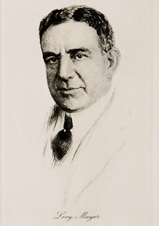
 |

Levy Mayer. Illustration from "Levy Mayer And The New Industrial Era," Edgar Lee Masters (1927).
There were simply not enough hours in the day for Levy Mayer (pronounced LEE-vee MAY-ur), a child prodigy who became one of the top lawyers in the country.
Born in Virginia in 1858 as the sixth of 13 children of Bavarian immigrants, Mayer and his family moved to Chicago when he was 5 years old. He soon showed himself to be an incredibly gifted student. Chicago High School made a special exception and admitted Mayer at only 12. After graduating at 16, he and his family persuaded Yale to waive its requirement that students must be 18 to enter.
After graduating in 1877, Mayer returned to Chicago, where he fought for business deregulation. He helped organize the Illinois Manufacturers’ Association, a trade organization that was created in part to challenge the constitutionality of the Illinois Factory Inspections Law of 1893, which limited women to work only eight hours per day. In the 1895 case Ritchie v. People, brought by Mayer and the association, the Illinois Supreme Court declared the eight-hour provision for women unconstitutional because it violated a woman’s right to contract for her labor.
Mayer was a founding partner of the global law firm Mayer Brown, which employs more than 1,600 attorneys.
Designed by James Gamble Rogers, Levy Mayer Hall is known for its ivy-covered walls, stained glass windows and distinguished interior spaces, including Lincoln Hall, a scaled-down version of the British House of Commons.
Stories by Stephanie Haines (WCAS15), Margaux Pepper (C14) and Danny Moran (J13).
Tell us what you think. E-mail comments or questions to the editors at letters@northwestern.edu.
Ever wonder about those strange designations we use throughout Northwestern to identify alumni of the various schools of the University? See the complete list.